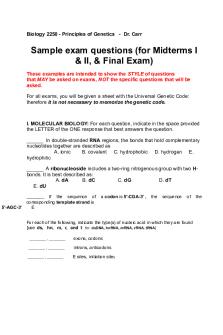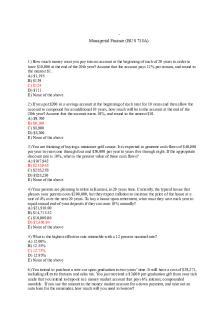Electromechanical Systems Exam questions PDF

| Title | Electromechanical Systems Exam questions |
|---|---|
| Course | Electromechanical Systems |
| Institution | Loughborough University |
| Pages | 4 |
| File Size | 193 KB |
| File Type | |
| Total Downloads | 26 |
| Total Views | 130 |
Summary
Download Electromechanical Systems Exam questions PDF
Description
ELECTROMECHANICAL SYSTEMS (15ELB003) June 2016
2 Hours
Attempt as much of the paper as you can – 100 marks are available Any University approved calculator is permitted.
1. a)
b)
c)
d)
A coil of 32 turns is rotated at a speed of 1050 revs/min inside an 8-pole arrangement of magnets. If the useful flux/pole produced by the magnets is 2.5 mWb, determine the frequency and the rms value of the emf induced in the coil assuming that the emf is sinusoidal.
[6 marks]
A three-phase 6-pole 50 Hz induction motor operates at 4.5% slip at fullload when its output torque is 150 Nm, determine the speed in revs/min and the output power.
[12 marks]
A small transformer core weighs 4.6 kg. The manufacturer quotes a material density of 8100 kg/m3 and a total loss density of 18630 W/m3 when operating at the transformer's nominal frequency and flux density. Determine the power loss in the core under the nominal conditions.
[4 marks]
A coil of 200 turns is wound uniformly over a plastic ring having mean circumference of 600 mm and a uniform cross-sectional area of 500 mm2. If the current in the coil is 4 A dc and assuming that the flux is confined to the ring, calculate: i.
The coil mmf.
[3 marks]
ii.
The magnetic field strength on the mean flux path.
[3 marks]
iii.
The flux density on the mean flux path.
[3 marks]
iv.
The total flux in the ring.
[3 marks]
v.
The self-inductance of the coil.
[4 marks]
1 of 4
/continued
2.
A single-phase transformer has approximate equivalent circuit parameters rm = 1350 Ω, xm = j850 Ω, R1 = 1.35 Ω, X1 = j2.42 Ω and N1:N2 = 2.5:1. The transformer operates with a constant primary voltage of 110 V.
3.
a)
Determine the no-load primary current, power factor and iron loss.
b)
Estimate the secondary current when the transformer is loaded and operating at its maximum efficiency.
[12 marks]
[9 marks]
The 200-turn coil of the loudspeaker illustrated in Figure Q3 below is of 20 mm mean diameter and has a resistance of 15 Ω. The coil lies in the uniform radial magnetic field of 0.9 T produced by an annular magnet system. The coil is attached to a diaphragm that is supported at its rim by a flexible annular ring of compliance 0.01 m/N. a)
b)
The coil is supplied from a constant voltage supply of 0.6 V, determine the force produced on the diaphragm by the coil and the deflection of the diaphragm in mm (in the x direction).
[9 marks]
The coil is supplied from an alternating voltage supply of 0.6 V rms. Assuming that the supply varies sinusoidally and that the effect of movement can be ignored, determine the peak force produced on the diaphragm by the coil.
[9 marks]
flexible annular ring
conduct or adhesive carrier
S
magnet
x N
S
diaphragm
Figure Q3
2 of 4
/continued
4.
Locked rotor, no-load and load tests were conducted on a small 4-pole woundrotor induction motor. The per/phase (star) parameters, for the approximate equivalent circuit of Figure Q4, were determined from the test results to be: rm = 1050 Ω, xm = j40 Ω, Rs = 0.85 Ω, Rr/ = 1.25 Ω, (Xs + Xr/) = j3.85 Ω The mechanical losses were found to be 370 W at synchronous speed.
Figure Q4 For the load test the motor was supplied at 230 V (line), 50 Hz and the mechanical load increased until a motor line current of 5 A was obtained, at which point the motor input power was 1250 W and its speed 1455 revs/min, determine: a)
The output power.
[17 marks]
b)
The output torque.
[6 marks]
Dr Keith Gregory
3 of 4
/continued
Useful information Magnetic materials and circuits Pe = k e (f Bm )2 W m3 Ph = k hf B mx W m 3 Px = k x (f Bm )3 2 W m3 µ 0 = 4 π ×10 −7 H / m
Transformers
voltage regulation =
no - load voltage − full - load voltage no - load voltage
voltage regulation ≈
I′2 (R1 cos φ2 ± X1 sin φ2 ) V1
η=
n × V2I 2 cos φ2 n × V2 I2 cos φ2 + Pi + n 2 × Pc
Force and torque production
T = 1 I12 2
dM dL1 1 2 dL 2 Nm + 2 I2 + I1I 2 dθ dθ dθ
Induction motors s=
ns − nr Ns − Nr ωs − ωr = = ns Ns ωs
Ir′ =
Pm =
Tm =
Vs
(R s + R′r s)2 + ( X s + X ′r )2 Vs 2
(R s + R′r s)
2
+ ( X s + X ′r )
2
×
R′r (1 − s ) W s
2
×
R′r Nm s ωs
Vs 2
(R s + R′r s)
s tm =
2
+ ( X s + X ′r )
A
Rr′ Rs2
+ ( Xs + X′r )2
4 of 4...
Similar Free PDFs

Info Systems Final Questions
- 3 Pages

Web Systems Final Exam Notes
- 5 Pages

Web Systems Final Exam Notes
- 32 Pages

Exam, questions
- 1 Pages

Exam Questions
- 9 Pages

Exam, questions
- 7 Pages

Exam, questions
- 9 Pages

Exam, questions
- 62 Pages

Exam, questions
- 8 Pages

Exam, questions
- 5 Pages

Exam, questions
- 5 Pages
Popular Institutions
- Tinajero National High School - Annex
- Politeknik Caltex Riau
- Yokohama City University
- SGT University
- University of Al-Qadisiyah
- Divine Word College of Vigan
- Techniek College Rotterdam
- Universidade de Santiago
- Universiti Teknologi MARA Cawangan Johor Kampus Pasir Gudang
- Poltekkes Kemenkes Yogyakarta
- Baguio City National High School
- Colegio san marcos
- preparatoria uno
- Centro de Bachillerato Tecnológico Industrial y de Servicios No. 107
- Dalian Maritime University
- Quang Trung Secondary School
- Colegio Tecnológico en Informática
- Corporación Regional de Educación Superior
- Grupo CEDVA
- Dar Al Uloom University
- Centro de Estudios Preuniversitarios de la Universidad Nacional de Ingeniería
- 上智大学
- Aakash International School, Nuna Majara
- San Felipe Neri Catholic School
- Kang Chiao International School - New Taipei City
- Misamis Occidental National High School
- Institución Educativa Escuela Normal Juan Ladrilleros
- Kolehiyo ng Pantukan
- Batanes State College
- Instituto Continental
- Sekolah Menengah Kejuruan Kesehatan Kaltara (Tarakan)
- Colegio de La Inmaculada Concepcion - Cebu




